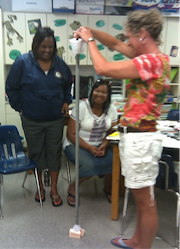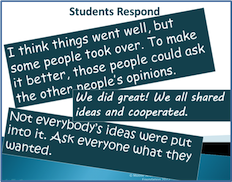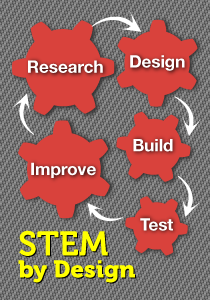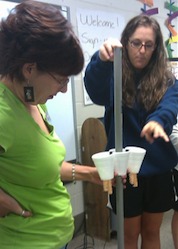Engage Your Students with STEM Launchers!
A MiddleWeb Blog
Two STEM launcher activities, like those described here, are now available through MiddleWeb. Free! Visit Anne Jolly’s 2017 post Use a STEM Launcher Activity to Kick Off Your Program! to learn about the ‘Bama Bears Challenge. And visit Anne’s website for her book STEM by Design to read about and download the Drop, Stop, Don’t Pop! Challenge.
I’ve asked Carolyn DeCristofano to be my guest blogger this week. Carolyn is a top-notch STEM specialist, President of Blue Heron STEM Education, and an acclaimed author who has written publications for NOVA and the Boston Museum of Science.
Now that I’ve given you the basics on one of STEM’s more creative imagineers and curriculum writers, let me say that Carolyn is an insightful developer and trainer in the STEM area.
In Carolyn’s post you’ll discover a process she spearheaded for introducing the STEM process to students and teachers. That’s oversimplifying things a bit, but I’m eager for you get to her article. What a wealth of knowledge! Thanks, Carolyn, for sharing your wisdom. And thanks for the offer of a free Launcher lesson at the end of your post!
Launching into Middle School STEM Success
by Carolyn DeCristofano

We also want them be able to be creative and successful in teams. This goes far beyond splitting up work tasks in equitable, peaceful ways, and it is hard work. We may have other goals, as well, but certainly these aspirations are part of the core.
In many classrooms, carefully designed engineering challenges prove to be important catalysts for students engaging in their science and/or math knowledge to solve problems in teams. Engaging Youth through Engineering (EYE), a project that host blogger Anne Jolly has described on this site in the past, is one resource for such lessons.
A few years ago, Anne and I joined our other colleagues on the EYE team to review both the project successes and needs for growth. We recognized that in teachers’ day-to-day press to simply keep up with the school year, some of the key lessons we hope students will learn as a result of our modules are in danger of being lost. Engineering-based modules that integrate math and science have a lot of cognitive load; we were concerned that the more subtle lessons might not be consolidated.
More specifically, we noted the following about the program at that early phase in its development, and formulated some questions about how our program might respond:
• Teachers liked the modules, finding that the students’ engagement in class soared with them – but also observed that teamwork issues bogged the students down. How could we provide teamwork support in productive ways, without adding too much to the teaching time required of the modules?
• We and the teachers valued the engineering design process theme embedded in the modules, but we were concerned that there is very little time to formally introduce the process. Stopping to introduce the process or, worse, simply imposing it on students, was unsatisfactory from the perspectives of flow and pedagogy. How could we ensure that students became aware of and fluent in the engineering design process, without making it formulaic in the modules?
• Our students were not starting out with common experiences and engineering vocabulary. While some students had never encountered an engineering design process, some of our Mobile cohort had participated in elementary level EiE programs, and thus were familiar with the 5-step engineering design process. How might we introduce our more detailed 8-step process to essentially two cohorts with radically different experiences? What should we as a program do to respond to all of these issues?
Our solution was to develop “Launchers,” so-called because they help launch a productive STEM school year. Let’s see how this idea of these lessons was, well….launched!
Long Ago and Far Away

The professional development activity was an adaptation of a classic and simple mini-challenge for small teams. Could teams help a museum increase the visibility of a too-small statue (stuffed animal) by designing and creating a tall, stable tower that could support its weight, using tape and a limited number of index cards? How well could they accomplish this with just 20 minutes to complete the task?
That version of the mini-challenge encompassed some hallmarks of a great introduction to engineering:
- It is short and relatively uncomplicated – and highly accessible.
- It engages learners in doing engineering, right off the bat.
- The challenge is introduced within a human context, underscoring the idea that engineering is a response to human needs, problems, or desires – not just an exercise in getting technical things to work.
- The experience is structured to ensure that participants will gently bump into some of the key ideas about engineering that we facilitators would later help them debrief.
- The solutions from team to team can vary broadly.
- After the teams work on the challenge, facilitators have an opportunity to prompt participants to list the types of steps involved in designing a solution to a problem. This list becomes a bridge to understanding more formal presentations of the engineering design process.
The EYE team wondered whether this type of experience – a mini-challenge – could be used at the beginning of the year to introduce the engineering content. However, we knew that the teamwork lessons and the connections of math and science to engineering would have to be made explicit. We would need to make some changes.
Middle Grades Engineering Launchers
for the Start of Every School Year
Of course, a classroom teacher was at the heart of our transition from mini-challenge to school year launcher. Years before, a friend of mine had casually mentioned that she thought this engineering activity was something she could use to kick off her school year. She saw it as a chance to set out the values she wants her students to focus on: teamwork, process as well as product, risk-taking. She helped me see that this mini-challenge could be multi-dimensional. The EYE team took off with this idea, and the Launcher concept soon jelled.
We decided to create “something like the tower” activity as a way to launch the school year. We know that teachers frequently spend the first few days helping their students get oriented to their classroom. This is the time to set expectations, lay the groundwork, and make some powerful statements (in actions and words) that preview the year ahead.
Adapted for the middle school classroom, our activity would do double-duty. It would be a tool for achieving universal goals, while also addressing STEM-specific goals. Because of this dual purpose, the STEM lessons would not take time from other prioriites. Teachers could use time already set aside for getting their students ready for learning.
As a bonus, we could create a 2-lesson progression that would take place in science and in math class, opening an opportunity to point out that engineering involves both of those content areas. We realized, too, that students could take their teamwork learning from one setting to a new setting, with different teammates. This would provide a sort of Restart option for students just beginning to focus on teamwork as a set of skills.

EYE’s Launchers Were Officially Launched!
Each launcher – one for each grade level (6-8) – is a 2-part, 90-minute lesson that introduces a design challenge in math or science class and provides an opportunity for redesign in the other content area’s class. Moving from one content area classroom to another, students sort out some important ideas about teamwork – and then practice applying those ideas with new team members.
The engineering design process – as a process – is also introduced and reinforced as a way of tackling problems systematically. Our launchers have become an important aspect of EYE’s program, a chance to introduce students and teachers alike to a year energetically punctuated by engineering and all the benefits it brings.

For example, in Grade 6, students are explicitly introduced to the idea that they will practice “active listening and contributing” in a team. Throughout the Grade 6 Launcher and modules, student discussions, team self-assessments, and written materials emphasize what it takes to listen and contribute actively.
A Launch is Only the Beginning
I want to be clear: Launchers cannot do everything that a more developed, carefully designed engineering challenge can do. The key is: They launch a year of possibilities, and so they serve a vital role in an integrated STEM classroom or school.
It’s important to follow through with those possibilities by providing deeper experiences that allow students to practice, broaden, and improve their engineering, science, math, and teamwork skills and knowledge. EYE modules or other carefully designed integrated STEM experiences can do this.
If you have never brought an engineering challenge into your classroom, you might want to try a launcher, even if we are well into the school year.
Or maybe you have already been doing something like this for a while.
Either way. . . whether you are new to this idea or accustomed to using mini-challenges in multi-dimensional ways, please share your experiences and observations. What works well? What is challenging? What surprises you? What do students have to say about the experience?
If you have already tried similar mini-challenges, take a look at the Launcher. How does the Launcher compare/contrast with what you’ve done before?
Let us know!








































Anne, you wrote:
“And thanks for the offer of a free Launcher lesson at the end of your post!”
I cannot resist: Who says there’s no such thing as a free launch?
(The launcher lesson comes courtesy of the EYE program.)
Carolyn, what a terrific overview and explanation of the Launcher program you initiated at EYE. This is such an important part of implementing a successful STEM program – how do we help kids (and teachers) understand what an engineering challenge is and what teamwork is? How do we get everyone on the same page? Once they are grounded in that understanding, the STEM lessons themselves go so much more smoothly.
I highly recommend that readers ask for a free launcher – these are well developed, field tested, and effective. Go for it!
Are we able to purchase additional launcher lessons? I would like to do a different one for each of my grade levels. Thank you!
I would also love another launcher so that I have a different one for both my grade levels 5/6. Where can I find these?
Please email me and I’ll send you another. ajolly@bellsouth.net